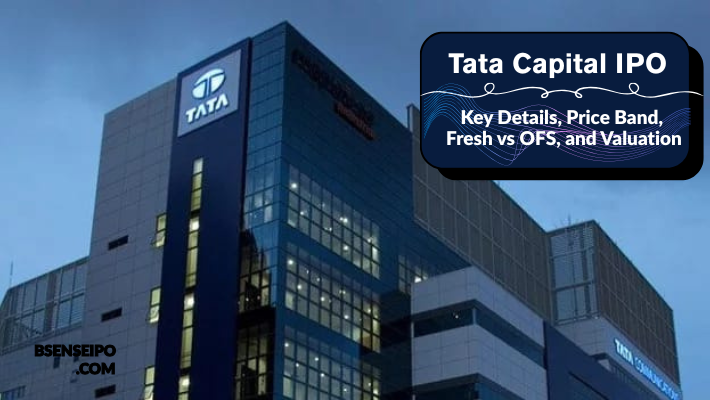Tata Capital Limited to Raise ₹15,500 Crore via IPO — Structure, Risks, Strategy
Tata Capital, one of India’s leading non-banking financial companies (NBFCs) under the Tata Group, is launching one of the largest IPOs in recent times in the Indian financial services sector. The offer includes both a fresh issue (new shares) and an offer-for-sale (OFS) component. With regulatory mandates, strong financials, and plans for growth and scale, this IPO is being closely watched by investors.
- Tata Capital Limited (TCL) is the flagship financial services company of the Tata Group and a diversified Non-Banking Financial Company (NBFC).
- It is classified as an Upper Layer NBFC by the Reserve Bank of India (RBI), which mandated its listing.
- The company offers a wide range of financial products and services, including: Commercial Finance, Infrastructure Finance, Wealth Management, Consumer Loans (Home Loans, Vehicle Finance, Personal Loans), and Distribution Services.
- It serves over 70 lakh customers (as of June 30, 2025) and is ranked as the third-largest diversified NBFC in India by total gross loans.
Key Tata Capital IPO Details & Structure
| Feature | Detail |
|---|---|
| IPO Dates | Opens on October 6, 2025, and closes on October 8, 2025. Anchor book bidding starts October 3. |
| Price Band | ₹ 310 to ₹ 326 per equity share (face value ₹ 10) .
The IPO price band of values the company at approximately . |
| Lot size/Minimum | Lot size is 46 shares. Minimum amount = Lot size × lower band price = ~₹14,260 for retail. |
| Issue Size/Amount to be raised | Total IPO size ~ ₹ 15,511.87-₹ 15,512 crore (~US$2 billion). Includes fresh issue + OFS. |
| Fresh Issue | ~21.00 crore new shares to raise fresh capital. |
| Offer For Sale (OFS) | ~26.58 crore shares to be sold by existing shareholders. Of the OFS: Tata Sons to sell ~23.00 crore shares; IFC (International Finance Corporation) to sell ~3.58 crore shares.
|
| Use of IPO Proceeds | Fresh issue portion to be used to augment Tier-I capital, meet future capital needs, expansion of lending business, and corporate/general purposes. OFS proceeds go to the selling shareholders. |
| Listing | The shares are expected to list on both NSE and BSE, likely by October 13, 2025. |
| Allocation among investor categories | Retail investors (~35%), Qualified Institutional Buyers (QIBs) ~50%, Non-Institutional Investors (NIIs) ~15%. Also a small reservation for eligible employees. |
Financial Performance & Positioning
- Loan Book/AUM: As of March 31, 2025, Tata Capital had assets under management (loan book/gross loans) of ~ ₹2.2-2.3 lakh crore.
- Revenue/Profit Growth:
FY 2023 → FY 2024 → FY 2025: Revenue/interest income and profit after tax have shown healthy growth. E.g., profit after tax: ~₹3,327.0 crore in FY 24 to ~₹3,655.0 crore in FY 25. - Branches & Reach: As of June 2025, the branch network spanned over 1,500+ branches (1,516) across 1,109 locations in 27 states/UTs.
- After TMFL Merger: The merger with Tata Motors Finance Ltd (TMFL) (approved by boards) has broadened the vehicle financing business. Post-merger, TMFL contributes substantially to Tata Capital’s commercial vehicle loans, car loans, and supply chain finance portfolios.
Parent/Ownership & Corporate Structure
- Parent Company: Tata Capital is a flagship financial services subsidiary of Tata Sons Private Limited, which holds the majority shareholding (~88.6-92.8% depending on the report).
- Other Shareholders: International Finance Corporation (IFC) is a minority shareholder and will participate in OFS.
- Subsidiaries / Child Companies: Key business verticals under Tata Capital include a housing finance arm (Tata Capital Housing Finance), wealth services, distribution of financial products (e.g. Tata Cards), etc. After the merger, vehicle finance (through TMFL) is integrated.
Strategic & Future Plans
- Regulatory compliance:
- RBI had designated Tata Capital as an “upper-layer” NBFC, which mandates that such NBFCs must be listed within three years of the notification. The IPO is, in part, driven by this requirement.
- Branch & Geographic Expansion:
- Physical branch network has expanded rapidly in the recent past: from ~175 to ~700 in a span of ~2.5 years, and now over 1,500 branches.
- Both physical + digital expansion are being emphasized.
- Technology/AI/Digitisation:
- Emphasis on leveraging artificial intelligence for improving customer servicing, risk management, chatbots, marketing analytics, etc. Already used for answering a large percentage of customer queries.
- More efficient credit underwriting, better collection infrastructure.
- Business Mix/Cross-Sell Strategy:
- With the TMFL merger, the vehicle finance business has been broadened to a multi-OEM model, not just restricted to one brand. The plan includes increasing the share of used and small/light commercial vehicles to improve yield.
- Use of its existing customer base to cross-sell (e.g., wealth, insurance, cards) especially in retail & SME segments.
- Capital Augmentation & Financial Strength:
- Fresh capital raised will strengthen Tier-1 capital, allowing growth in the lending book.
- Focus on reducing cost of funds, improving margins, optimizing the cost/income ratio.
- Risk Management/Asset Quality Improvement:
- Steps to maintain good asset quality (non-performing assets) post the vehicle finance expansion. Strong risk management and improved collection processes are priorities.
Risks & Challenges
- Valuation and Pricing: The IPO price band (~₹310-₹326) implies fairly high P/E multiples vs peers; risk that investors might think it is priced steeply.
- Execution risk in integrating TMFL business and managing vehicle finance (vehicle loans can have higher risk due to defaults, etc.).
- Regulatory/macro risks: NBFC/credit cycles, interest rate environment, regulatory oversight.
- Competition in NBFC/fintech/digital lenders, margin pressure, cost of funds.
Likely Market Outlook & Investor Considerations
- The Tata Capital IPO is expected to be among the largest of FY2025-26 in the financial services / NBFC space.
- Strong brand (Tata), diversified portfolio (retail, SME, vehicle finance, housing finance) gives it an advantage.
- Long-term investors may favor this IPO if one believe in a stable credit environment and NBFC sector growth in India.
- The discount (if any) to unlisted share valuations may attract interest; retail portion (~35%) gives retail investors a chance.
- Monitoring performance post-listing: growth in loan book, margin trends, asset quality, cost ratios, and impact of interest rates.
(Disclaimer: Recommendations, suggestions, views and opinions expressed by experts are their own. Investors are advised to consult certified financial advisors before making any investment decisions.)




